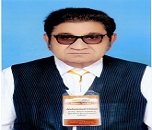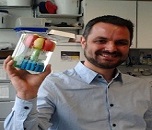Scientific Program
Keynote Session:
Title: Laboratory Quality Management System and IS/ISO 15189 accreditation: A Management Tool
Biography:
Neelima Verma is currently associated with Fortis Healthcare, India. She completed her PhD in the year 1989 and has since worked in various highly reputed hospitals of Delhi. He has been actively involved in improving Laboratory Quality management Systems and is currently NABL Medical Lead assessor. She has many a feathers in her cap. She is also guest faculty with National institute of training and Standardization and quality Council of India for ISO 15189:2012 IA course. She is a life member of ACBI and ACBM. She has more than 20 National and International publications to her credit and has been actively participating in various national and international conferences/ seminars and promoting the cause of research in the field of Biochemistry. She is review board member of reputed journals too.
Abstract:
Medical testing Laboratories provide vital services to their customers (Patients, clients) who expect accurate results produced at given time. Adoption of the Quality Management System (QMS) by a laboratory would facilitate achieving their goals. A Quality management System (QMS) can be defined as’ Coordinated activities to direct and control an organization with regard to quality’. After the introduction of International Standard for the QMS professionals of Medical laboratories have been showing increasing interest for understanding the QMS and attaining accreditation status for their services. Compliance with IS/ISO 15189:2012 provides a unique focus for implementation of Laboratory Quality Management System and another Important international standard for Laboratories is CLSI which uses a consensus process involving many stakeholders for developing standard. As Medical testing is a complex system, involving many steps of activity so it requires that many procedures and processes be performed properly. To make it convenient entire path of workflow has been divided into three phases- pre examination, Examination and Post examination processes.
Title: Identification methicillin-resistant Staphylococcus aureus by using loop-mediated isothermal amplification combined with a lateral flow dipstick
Biography:
Thongchai Kaewphinit received the MSc in Biomedical Science from Srinakharinwirot University (SWU), Thailand in 2007, and PhD in Molecular Biology from SWU in 2010. Recently, he is a Lecturer of Innovative Learning Center, SWU. Biosensor, nanotechnology, molecular biology and applied microbiology are his current research field. He has published more than 12 papers in refereed journals.
Abstract:
Infectious disease in hospitals is a major public health problem that is increasing every year due to advance in medical health science tools for patients are numerous. It is increased the risk that patients have been infected with pathogens from contaminated instruments Medical Equipment including contamination in healthcare worker routine such as Staphylococcus aureus, methicillin-resistant Staphylococcus aureus (MRSA). In particularly MRSA, the antibiotic-resistant superbug usually associated with hospital infections. Nowadays, molecular biology based assays, such as PCR (polymerase chain reaction) test, these techniques entail various disadvantages such as high cost, time consuming, or use of toxic substances. Novel loop-mediated isothermal amplification (LAMP) permits DNA to be amplified rapidly at a constant temperature. Here, a LAMP procedure was integrated with a lateral flow dipstick (LFD) specifically and rapidly under isothermal condition. The DNA amplicon hybridized to detection 5 min after application. The reaction was optimized at 61 â—¦C for 45 min and amplified DNA was detected at LFD test line 5 min after application. The result showed that the sensitivity limited of detection was 100 fg. The specificity was no cross-reactions with other bacteria. This assay showed high sensitivity, relatively short analysis time, low cost, and the lack of requirement for a thermocycler were important advantages of this technique. Due to its simplicity, rapidity and high sensitivity, LAMP might be used as the alternative technique for MRSA detection in medical diagnostic laboratories.
Title: The structural mechanism of transport by the mitochondrial ADP/ATP carrier
Biography:
Edmund Kunji holds a PhD in Mathematics and Natural Sciences from the University of Groningen and he has been an EMBO Postdoctoral Fellow with Richard Henderson at the MRC Laboratory of Molecular Biology, Cambridge. Since 2000 he is a Research Group Leader at the MRC Mitochondrial Biology Unit, University of Cambridge, where he works with his group on structures of transport proteins to elucidate the transport processes in mitochondria.
Abstract:
Mitochondrial ADP/ATP carriers in the inner membrane belong to the mitochondrial carrier family and they transport ADP into the mitochondrial matrix for ATP synthesis, and ATP out to the cytosol to fuel the cell. They cycle between cytoplasmic-open and matrix-open states, in which the substrate-binding site is alternately accessible from either compartment for ADP or ATP binding. We will present data that will resolve their mechanism in atomic detail. In agreement with earlier published data, the structural evidence demonstrates that the carrier functions as a monomer and has a single substrate binding site and two salt bridge networks that regulate access to this site in a conformation-dependent way. The structural analysis also explains the role of all conserved sequence features of mitochondrial carriers, showing that the mechanism is universal for this class of transport proteins.
Title: Phytochemical Screening of leaves and roots of Stylochiton borumensis: A medicinal plant
Biography:
Hatim Hamadnalla has completed his B.Sc from University of Juba, 2002 and Master of Science from University of Bahri, 2017. He is a lecturer of Biochemistry, College of Applied Sciences. And head department of laboratories.
Abstract:
The aim of this study was to find out phytochemical classes present in various extracts of Stylochiton borumensis roots and leaves and to determine the total phenolic, flavonoids and tannins content in different plant extracts. Total phenols, flavonoids and tannins content was determined by folin-ciocalteu assay, aluminum chloride colorimetric assay and ferric chloride colorimetric assay respectively. Different extracts of S.borumensis showed the presence of alkaloids, sterols/ triterpenoid, flavonoids, tannins and coumarins. The phenolic, flavonoids and tannins contents of plant extracts using gallic acid (Y= 0.0007x + 0.1078, r² = 0.9997), quercetin (Y= 0.0007x + 0.053, r²= 0.9984) and tannic acid (Y= 0.0009x + 0.043) as standards. The total phenolic content ranged from 460 to 530 mg/1 gallic acid equivalent in leaves and from 240 to 520 mg/1 gallic acid equivalent in roots. The total flavonoids content was ranged from 140.870 to 360.750 mg/1 quercetin equivalent in leaves and from 138.678 to 357.670 mg/1 quercetin equivalent in roots. The total tannins contents ranged from 210 to 300 mg/1 tannic acid equivalent in leaves and 190 to 270 mg/1 tannic acid equivalent in roots. The study showed significant amount of gallic acid, quercetin and tannic acid equivalents were present in S.borumensis extracts which may responsible for valuable pharmacological properties of the plant.
Title: The role of biochemistry used in daily life for the development of health
Biography:
Muhammad Usman has been the Former Director General of Agricultural Research System, Government of Pakistan who retired from service after a spotless career of about 35 years with senior level experience on research and development of integrated agricultural industries with regard to livestock and dairy development, poultry sustainable agricultural production system and biochemistry. He established “Prominent Agro Based Industries SDN BHD” in Malaysia and “Foundation for Rural Development in Pakistan”, with primarily aims to work on integrated agricultural project for Rural Development through improvement in agriculture for rehabilitation of affected area.
Abstract:
Biochemistry, sometimes called biological chemistry, is the study of chemical processes within and relating to living organisms. Biochemistry is the application of chemistry to the study of biological processes at the cellular and molecular level. The knowledge and methods developed by biochemists are applied to in all fields of medicine, in agriculture and in many chemical and health related industries. Biochemistry involves the study of what is going on in living cells on the molecular level and consist of proteins which is said that "life" depends on chemicals called as proteins. Carbohydrates and lipids are the other major types of biochemical. Carbohydrates serve two main purposes, to provide cell structure and energy to every cell. Cholesterol and trans-fatty acids are types of lipids. Biochemistry is the study of biological processes that occur in cells and organisms. Carbohydrates, lipids, proteins and nucleic acids are the most common biological molecules studied by biochemists. Biochemistry also encompasses the science of molecular biology. This includes immunochemistry, neurochemistry and bioinorganic, bioorganic and biophysical chemistry. Biochemistry is applied in various areas, including medicine, dentistry, industry, agriculture and food science. The discipline overlaps with many other fields of science, including pharmacology, physiology, microbiology and clinical chemistry. A multidisciplinary approach to research allows scientists to examine the mechanism of a drug action or conduct research related to organ functions. In the light of the above study, it is concluded that biochemistry plays and important role and without biochemistry life is almost impossible
Keynote Session:
Title: Structure of complete ATP synthase and its role as a new drug target against tuberculosis
Biography:
Prof. Dr. Thomas Meier is Chair in Structural Biology and Director Centre for Structural Biology. He belongs Department of Life Sciences in Imperial College London. He will also focus on biochemical and structural investigations of the ATP synthase with respect to the development of new antibiotics in the fight against infectious diseases such as tuberculosis.
Abstract:
F1Fo-ATP synthases are paradigmatic molecular machines, which use the transmembrane electrochemical ion gradient to power ATP synthesis. The enzymes belong to the class of rotary ATPases, which all share a common architecture, consisting of a rotor and stator entity. While ions are shuttled through the Fo complex of the enzyme, torque is generated at the rotor/stator and transferred to the F1-catalytic subunits for ATP synthesis. In the opposite direction, ATP hydrolysis can be used to drive ion pumping. In this present research the structure of the complete ATP synthase analysed by electron cryo-microscopy and X-ray crystallography shall be discussed. Also focus on biochemical and structural investigations of the ATP synthase with respect to the development of new antibiotics in the fight against infectious diseases such as tuberculosis.







